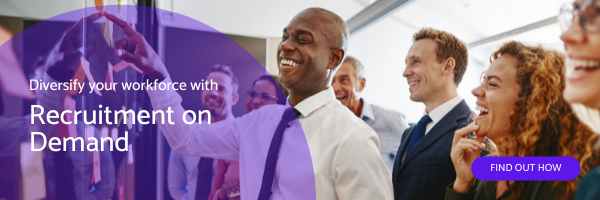As we enter 2022, Diversity and Inclusion has taken on a new importance. This determination to ensure Diversity, Equity and Inclusion is a top priority is evidenced by a 123% rise in job postings featuring DE&I during 2021. In addition, a Gartner survey highlighted that this trend would continue with unabated enthusiasm into 2022, revealing diversity, equity, and inclusion now ranks in HR leaders’ top five priorities.
In the workplace, diversity means an organisation intentionally employs people with a wide range of characteristics and beliefs. For example, different genders, religions, races, ages, ethnicities, sexual orientation, and education. By employing people from every walk of life, they can amplify voices from across their organisation and the wider community.
Why does Diversity and Inclusion need to be a priority in the workplace?
In 2022 diversity isn’t a nice buzzword to include in company literature or something to aspire to when you have more time but an absolute priority that will shape how your organisation is perceived as an employer brand and how your business functions.
Though the majority of businesses recognise that having an inclusive company culture is essential, many organisations still have a long way to go to achieve equity.
Employing a diverse workforce is a win-win for organisations as it benefits both the employees and organisation and can lead to numerous positive outcomes, including increased innovation and greater creativity from its employees.
By including people with different backgrounds, perspectives, and approaches, it promotes fresh, innovative ideas that can be the catalyst for cutting edge concepts and breakthroughs that can drive businesses to new heights and improve the experience enjoyed by employees.
McKinsey analysed 180 companies across the United States and Europe, and their research revealed that companies whose leadership was more diverse enjoyed superior financial performance over their less diverse rivals. Additionally, executive teams in the top 25% for diversity were more likely to have above-average profitability over organisations in the bottom 25% for diversity.
Deloitte also identified that an increased emphasis on workplace diversity boosted employee engagement. As engagement is closely linked to employee retention, companies can expect to retain their employees for longer because of their focus on diversity.
An additional benefit when you focus on improving your organisation’s diversity and inclusion is the improved perception of your employer brand. Why is this essential for organisations in 2022? Your customers and job seekers now expect companies to not just pay lip service to diversity and inclusion with a DE&I statement but to actively strive to promote equity within their organisation.
This act alone can set companies apart as DE&I pioneers, and they will benefit from improved consumer loyalty and may gain national recognition for their efforts in becoming a truly diverse organisation. This can take the form of being spotlighted in the media as in the recent Fortune article about the top companies for diversity and inclusion or Forbes piece on America’s best employers for diversity.
One final thought on the impact of a solid DE&I policy is its importance in attracting top talent in the current talent scarce recruitment market. In a recent survey, Glassdoor revealed that more than three out of four job seekers felt a diverse workforce in an organisation was an important factor when they were evaluating companies and job offers.
The importance of communicating Diversity and Inclusion within the workplace.
Many employees see Diversity and Inclusion initiatives and training negatively as a telling off, commenting that they are perfectly tolerant and accepting of everyone, so why do they need this training?
If business leaders view diversity as a solution to a problem, then this training can cause resentment and introduce resistance to diversity and inclusion initiatives, meaning that even the most well-intentioned interventions may do more harm than good. The key to avoiding this situation is effective communication around diversity and inclusion, not just explaining what you want to achieve with an inclusive culture but additionally why D&I is essential and beneficial for everyone at all levels of the business.
Below are a number of strategies to help you communicate diversity and inclusion in your workplace and see how small changes can make big differences in employee wellbeing.
Strategies to communicate Diversity and Inclusion
Communicating Communication
If you want to build a diverse and inclusive office, it is vital that your employees feel comfortable contributing to discussions around diversity in your organisation and are confident that their voices will be heard.
In a diverse environment, everyone should have the opportunity to express their ideas, even if their opinions are different from their co-workers. This freedom of expression needs to be a part of your corporate culture.
Recruiting Diversity
When an organisation understands that diversity and inclusion isn’t just a tick box that needs to be checked but can significantly influence the quality of the candidates that your organisation attracts when you’re recruiting, then your employees will strive to make diversity and inclusion front and centre part of your culture.
Additionally, not only does an inclusive office attract top talent in a marketplace that is in short supply of great candidates but will ensure that you are more likely to retain your most skilled and valuable employees.
A happier workplace
A number of studies have shown that a diverse workplace is a happy one and also a more efficient and productive one. Of course, we all want to connect as humans, but more importantly, we want to be valued for our authentic selves, whatever form that may take, and a diverse environment facilitates that for everyone.
Leading diversity
If your organisation’s leadership is inclusive, it will help your employees understand why diversity is essential and allow for more effective communication around the subject of diversity.
To facilitate your employees to better understand your organisation’s diversity and inclusion initiatives, consider holding question and answer sessions to allow employees to get on board with your D&I programme or mentoring to help employees to understand the value.
Different perspectives and solutions
The Harvard Business Review found that organisations that favoured ‘cognitive diversity’ were up to three times faster at solving business problems than their less diverse competitors. Additionally, according to Scientific American, a diverse workforce is far more intuitive, inventive, and profitable due to their diversity.
Strength comes from diversity
Studies carried out by McKinsey and Company show that a diverse organisation will outperform less diverse organisations in growth and profitability.
Diversity doesn’t just make an organisation a happier place to work but a stronger, more profitable business.
Diversity and Inclusion should be at the forefront for every organisation irrespective of size. It brings numerous benefits including the ability to attract and retain scarce top talent, increased productivity, profitability and promotes a happier more inclusive environment for employees at every level.




